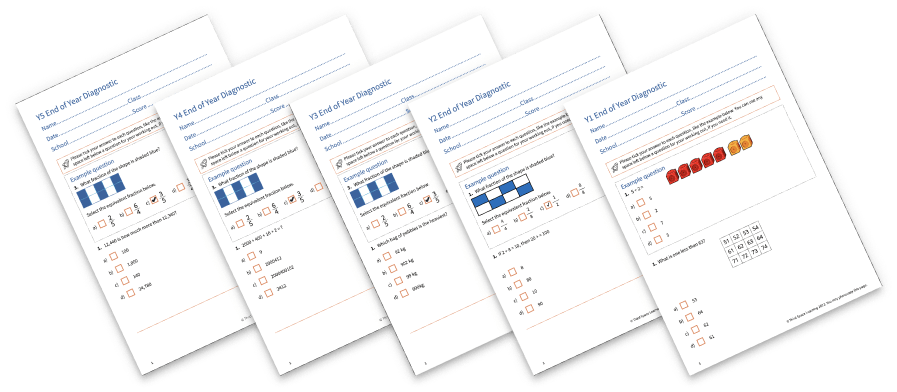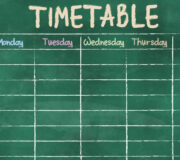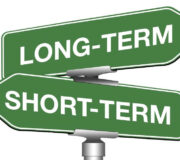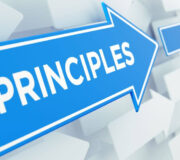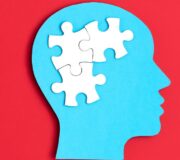Free Diagnostic Maths Test For Primary And Secondary Schools And How To Create Your Own
A diagnostic maths test is designed to identify students’ misconceptions or knowledge gaps. They are used to inform teachers’ decisions about the next stage of a lesson or programme of study.
Studies have shown these diagnostic tests to be one of the top three most effective techniques to improve student achievement (Wisniewski, Zierer, and Hattie). But their effectiveness is dependent on how and when the test is delivered and how the results are used. This guide will help you to understand how to use them to improve student learning, as well as share free diagnostic maths tests for primary and secondary for teachers to use.
What is a diagnostic maths test?
A diagnostic maths test provides teachers with a detailed understanding of the individual strengths and weaknesses of a student by precise analysis of the misconception in the answer that the student gives. A diagnostic maths test is most useful when focused on a narrow area of learning but it can be used more broadly to identify mathematical gaps and misconceptions.
A diagnostic maths test is a type of formative assessment or assessment for learning. Unlike summative assessments that are used to measure learning and track progress, a diagnostic assessment allows teachers to understand where knowledge gaps lie among students before, during or after a lesson has been taught.
The results of the diagnostic maths test can be used to inform any targeted support or personalised interventions for a student to improve academic achievement. For example when students start their online maths tuition with Third Space Learning, they have to complete a short diagnostic maths assessment to ensure tutors know both what to teach and any specific shortcomings there may be within a topic.
READ MORE: Formative and summative assessment
Structure and format of a diagnostic maths test
Most often, maths diagnostic tests are multiple choice questions set at a level appropriate for the student’s age and ability. A test should take no more than ten seconds for a student to complete, which means it can be used regularly throughout every lesson, providing frequent and detailed feedback to the teacher from every single pupil.
At Third Space Learning, all students sit a diagnostic maths test called ‘Mission Zero’ before they start their tutoring with us. This is a carefully designed multiple choice test where each incorrect answer reveals a specific misconception. It’s designed so that it should not be possible for a student to answer the question correctly while still holding a misconception. This means ‘Mission Zero’ diagnoses not only gaps in students’ learning but also the specific misconceptions that are holding them back.
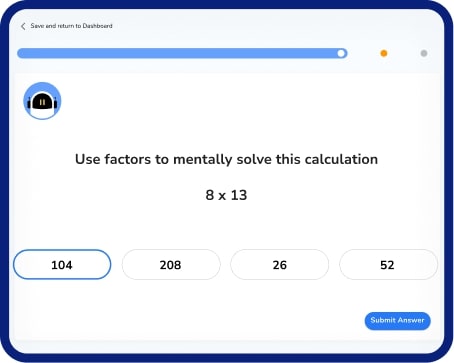
Alternative diagnostic tools for maths
If carefully created with the express purpose of diagnosing the error (not just providing a score or an ‘achieved/not achieved’ result) there are other tools that be used diagnostically such as a hinge questions or one off multiple choice questions.
Generally speaking other sorts of formative assessment tools you might use such as open-ended questions, closed questions or standard worksheets are not really suitable for diagnosing misconceptions.
READ MORE: Effective questioning
End of Year Diagnostic Maths Test Pack (Year 1-5)
This set of diagnostic maths tests provides an opportunity to assess pupils against the core objectives which they should be secure with by the end of the year and to inform your planning for the start of the Autumn term. Includes gap analysis template.
Download Free Now!How do diagnostic maths tests improve learner outcomes?
Students’ attainment improves when the results of a diagnostic maths assessment are used by teachers to identify when intervention is required and which topics should form the focus of that intervention. That is because by providing teachers with feedback about the effectiveness of their teaching methods and what learning has occurred, diagnostic maths tests can help teachers make informed decisions about how to proceed with learning.
READ MORE: Adaptive teaching
However, to capitalise on the effectiveness of diagnostic assessments, these tests should make it clear to the teacher what each incorrect answer reveals about their students’ understanding. Answer sheets should reveal details about students’ misconceptions, which students have given an incorrect answer, and why they have made a mistake. This has a powerful impact on teachers’ ability to make adjustments to the lesson and directly address students’ misconceptions to improve their learning and attainment.
Students can also benefit from these results as they receive feedback on their understanding, allowing them to become more reflective and self-regulated.
How diagnostic maths tests can lead to better pupil progress
Third Space Learning’s online one to one maths tutoring is guided by diagnostic assessment. Each and every pupil’s learning journey is personalised to their specific learning gaps and misconceptions through ‘Mission Zero’.
1. Diagnostic questions are carefully designed
Our assessments are carefully designed by former teachers and pedagogy experts. Each multiple choice question includes one correct answer and three distractors. Each distractor corresponds to a misconception a pupil may have.
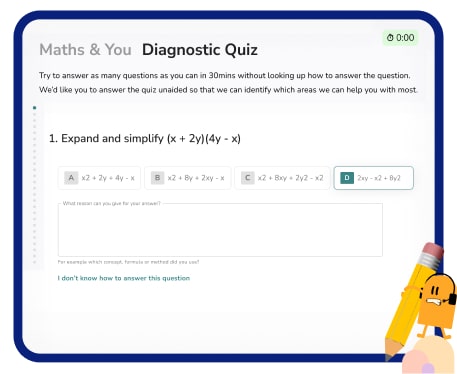
All pupils on our programmes, from KS2-KS4, sit this 30 minute initial diagnostic assessment prior to their first tutoring session as this helps to inform their personalised programme of lessons.
2. One question per learning objective on the programme
Each of the questions asked in the initial assessment relates to a single Learning Objective, mapped to each of the 500+ Learning Objectives in our online intervention curriculum.
3. Diagnostic maths test provides a benchmark
These initial diagnostic assessments additionally help to measure the impact of tutoring throughout the term. We compare the answers students give with post-session questions and their end-of-term assessment. Teachers have on-demand access to all student reports, including to the diagnostic maths test.
The progress of students during a term and their achievements on such a test however are subject to many factors, not just to do with what they have learnt with the tutors. For this reason we will always encourage a conversation with staff to drill down into the two sets of answers.
4. Continuous assessment for learning within each lesson
However, our use of diagnostic maths assessment doesn’t end with pupils’ initial assessment. Personalised learning goes beyond just selecting the right lesson for the right pupil; pupils also need to be guided through each lesson at the appropriate pitch and pace.
That’s why tutors are trained to ask questions throughout the session to assess each pupil’s understanding of the concept they’re learning and adapt their teaching accordingly. This gives pupils the best opportunity to make progress.
How to create an effective diagnostic maths test for your own maths lessons
There are three important areas for consideration when creating effective diagnostic tests for maths lessons:
- Effective design
- Classroom culture
- Professional development
1. Effective design of a diagnostic maths test
The tests should be well-designed and tailored to the individual needs of the class.
Multiple choice questions are the most effective form with questions purposely designed to make this happen if they hold any misconceptions. Each incorrect answer for the multiple choice question should relate to a different maths misconception and it should not be possible for a student to select the correct answer while holding a misconception.
2. A classroom culture that builds a low stakes environment with freedom to make mistakes
Students will inevitably give incorrect answers. So there needs to be a classroom culture that allows students to feel comfortable making mistakes and a shared growth mindset that incorrect answers represent an opportunity to improve learning.
Diagnostic questions will be counterproductive if they create anxiety as this adds to students’ cognitive load and makes it more difficult for them to learn new information. When teachers refer to incorrect answers as misconceptions, it can help to lessen the anxiety or blame felt by students.
3. Professional development
The most experienced teachers are likely to find it easier to identify the most common misconceptions associated with each topic as they will have encountered each one many times. This knowledge makes it easier to set the questions for the assessment. This is something that will develop naturally over time as a teacher’s experience grows but can be supported with resource sharing and professional development.
Sharing best practices is one of the most effective forms of teacher professional development. There are two ways in which sharing best practices can support colleagues improve students’ learning through the use of diagnostic assessments:
- Sharing premade diagnostic questions
- Sharing strategies and resources to successfully challenge students’ misconceptions
Third Space Learning has created diagnostic questions and free resources to support teachers’ intervention strategies that can be downloaded below. However, it is not enough to simply identify students’ misconceptions. Teachers need to develop the skills required to challenge and correct them.
Free and premium diagnostic maths tests
Even the most experienced maths teachers can find it a complex and time consuming task to create effective diagnostic maths tests. To free up your time, Third Space Learning has created a bank of free resources for teachers that include diagnostic maths tests that are suitable for students from key stage 2 to key stage 4.
And then to supplement these there are detailed per topic diagnostic assessments as part of our premium subscription.
Free detailed diagnostic maths tests for primary school and SATs
Misconceptions are a natural part of the learning process in mathematics. Identifying and challenging these misconceptions when they occur will prevent them from becoming ingrained and detrimental to learning in secondary school.
The free diagnostic assessments from Third Space Learning have been designed as pairs to be used at the start and end of a unit of study.
- The pre-test is an effective baseline assessment to inform teachers about their students’ prior knowledge and misconceptions. This allows teachers to deliver the subsequent lessons at an appropriate level and without including any unnecessary content that has been previously learnt.
- The post-topic diagnostic test can be used to assess whether the learning outcomes have been successfully met, whether any of the topics need to be retaught, or if any students need further support.
Each of the diagnostic maths assessments includes a detailed mark scheme that not only indicates the correct answer but also explains the distractor answers and misconceptions.
Free general diagnostic maths tests per year group
If you’re looking for something more general for your class there are also multi topic diagnostic maths tests for your year group. These can be used at the beginning or end of the year and come in two separate bundles to make this easier to manage.
LOOKING FOR MORE KS1 AND KS2 DIAGNOSTIC ASSESSMENTS?
Working with expert maths teachers we’ve created over 60 more detailed diagnostic maths assessments for all key national curriculum maths topics. These are available with a premium subscription to the Third Space Learning Maths Hub. They come in pairs so you can do a pre and post lesson quiz with pupils. 30 minutes well spent to get a detailed insight into each pupils strengths and weaknesses on a topic.
Free diagnostic maths tests for secondary school and GCSE
You can download over 50 GCSE diagnostic maths tests from this collection of Diagnostic Questions.
Each diagnostic maths test contains twenty multiple-choice questions that directly relate to the key skills required to master the GCSE topics. The incorrect answers have all been carefully selected to highlight a specific misconception, meaning that subsequent teaching can be targeted to improve learning and understanding most efficiently.
LOOKING FOR MORE KS3 AND KS4 DIAGNOSTIC ASSESSMENTS?
For a full selection of diagnostic maths tests available make sure you visit the totally free Secondary Resource Library. As well as diagnostic maths tests for all topics across Number, Probability, Geometry, Ratio and Proportion and Statistics, you’ll also find over 40 GCSE maths papers, hundreds of GCSE maths worksheets with exam questions and lots of GCSE maths revision resources.
Diagnostic maths tests FAQs
A diagnostic maths test is used to identify students’ misconceptions so that learning activities or instruction can be adapted to best meet students’ needs.
A multiple-choice diagnostic maths question should have one correct answer that can only be answered correctly if a student does not hold any misconceptions. Each incorrect answer should be designed to reveal a different misconception.
The purpose of formative assessments, such as diagnostic questions, are designed to improve learning by giving teachers information that can be used to adapt their teaching. Summative assessments are designed to provide information about what learning has occurred, such as an end-of-topic test.
DO YOU HAVE STUDENTS WHO NEED MORE SUPPORT IN MATHS?
Every week Third Space Learning’s maths specialist tutors support thousands of students across hundreds of schools with weekly maths intervention programmes designed to plug gaps and boost progress.
Since 2013 these personalised one to one lessons have helped over 150,000 primary and secondary students become more confident, able mathematicians.
Learn about the diagnostic assessment or request a personalised quote for your school to speak to us about your school’s needs and how we can help.

